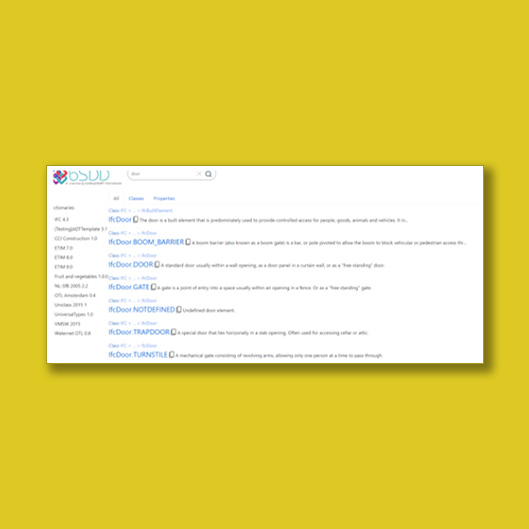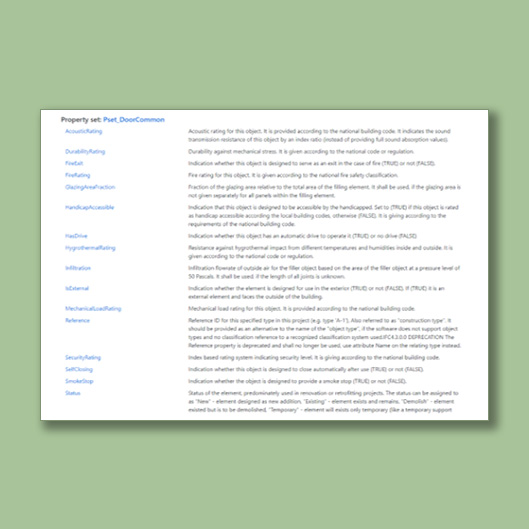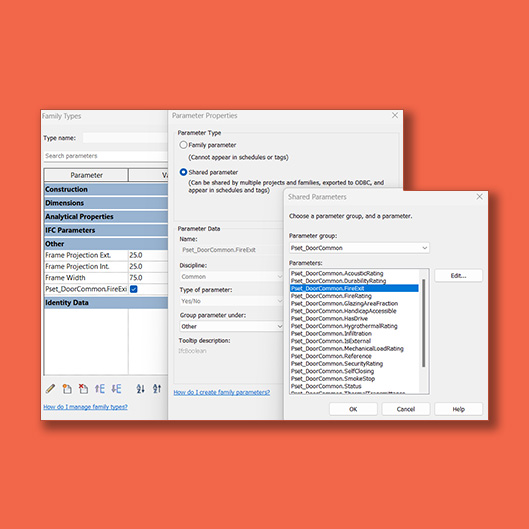The Journey of Data
From Product Data Template (PDT) to Asset Information Model (AIM)Background
The changes to the Building Safety Act state that information must be digitalised via a Common Data Environment (CDE) and satisfy the six requirements shown in Figure 1.
The need for manufacturers’ BIM objects with accessible, reliable, and readable data is essential. In 2023, over half of manufacturers will have digital objects for all or most of their key projects (56%, according to the NBS 2023 Digital Construction Report) (NBS, 2023).
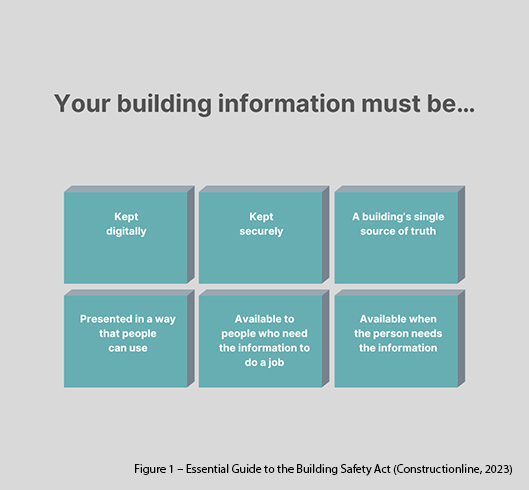
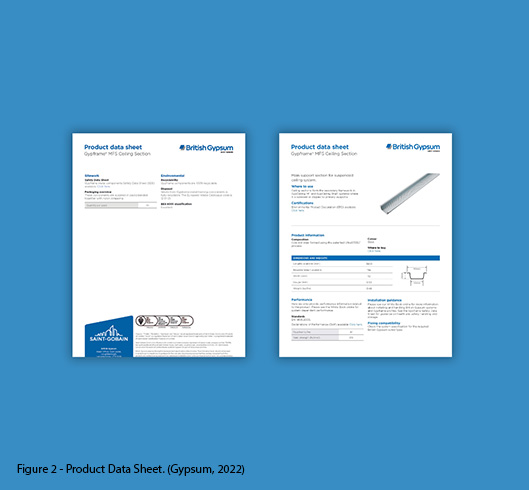
Introduction to Product Data Templates (PDT)
A product data template (PDT) initiates the data required for any given component. A PDT is a specific document that captures general and unique product characteristics. Once completed, the document is referred to as a Product Data Sheet (PDS), and the creator then holds ownership of that data and is responsible for its accuracy.
A Product Data Sheet (PDS) is a document identifying a product specification, listing critical information about the product’s physical size, material attributes and manufacture details. The concept is not uniquely related to Building Information Modelling and is a standard document that many manufacturers will have readily available to customers.
For example, product dimensions, weight, and manufacturer details. In Figure 2, a PDS for a support section for a suspended ceiling system, Yield Strength, and Reaction to fire. (Gypsum, 2022)
A product data sheet allows consumers to compare products. It would be ideal if suppliers selling similar products used the same templates to ensure data is compared like for like. A PDS can be created using essential software such as Word and Excel and shared or downloadable as a PDF or tables on a website.
Purpose of PDTs (Association, 2023)
- Simple information exchanges
- Reduce manufacturer effort in responding to requests for information
- Reduce manufacturer and distributor risk
- Simplify information usage
- Record of information exchange
- Automate processes using product information
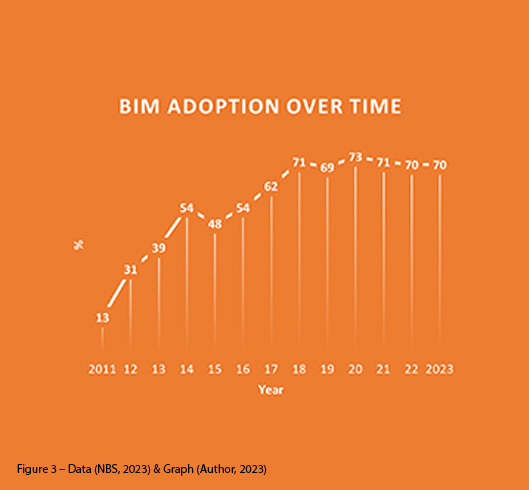
Adoption of Building Information Modelling (BIM)
Building Information Modelling (BIM) has various meanings depending on the organisation and where they are on their BIM adoption journey. In 2011, just 12 years ago, 75% of organisations were only producing 2D CAD drawings or not using CAD at all, with as little as 13% implementing BIM (NBS, 2011). For the last five years, BIM Adoption has been maintained at around 70% (NBS, 2023).
The government’s 2011 construction strategy accelerated the wake of digitalisation within the UK construction industry. The UK Government required fully collaborative 3D BIM on centrally procured government construction projects (with all project and asset information, documentation, and data being electronic) at a minimum by 2016 (Office 2011).
Here, the term ‘BIM Level 2’ was born and became the goal for compliance.
BIM Level 2
BIM level 2 introduces collaborative working and data sharing at various project stages, including graphical and non-graphical data. PAS 1192-2
defined how much data is required and at which stages of a project; this is described as the Level of Detail (LOD) for graphical information and the Level of Information (LOI) for non-graphical.
Data must be easily shared across all stakeholders using a common file format, such as IFC, COBie or an agreed upon native software at the contractual stage, such as Revit. It is also critical that data is stored and shared securely and is trackable; a Common Data Environment (CDE) provides a cloud-based platform to upload published documents for access to the broader team.
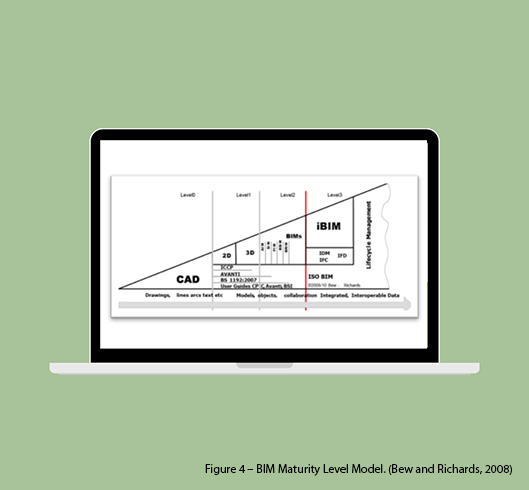
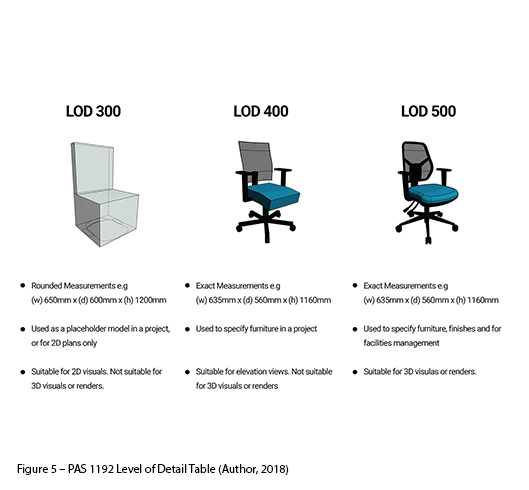
ISO 19650
Up until 2019, information was defined in PAS 1192 as LOI and LOD across a number scale of 1-7. The number scale was superseded to ‘Level of Information Need’ as LOI/LOD was too generic. For example, requesting LOI 4 for furniture does not define the required information and its purpose. Figure 5 represent 1 of many tables aiming to define what each level includes.
PAS 1192 was withdrawn in 2019 and superseded by ISO 19650, an international standard based on the fundamentals of PAS 1192
The Level of Information Need Framework should be defined at the Strategic Definition stage of a project. Understanding the prerequisites defines why, when, by whom and what information is required. Data should only be given for a purpose, and the framework defines that the minimum is enough; any information beyond this is considered too much. (Framework, 2022)
BIM Objects
A BIM object is a 3D digital model representing a physical product with associated product data. Each component within a Building Model is a separate object, from columns to doors, furniture to carpets. Aside from generic information (COBie), the data assigned to each depends on the product type. Columns would need strength loads; the door would need a fire rating. This data requirement is assumed to align with the Product Data Sheets. However, the translation from PDS to BIM authoring systems needs to be improved.
The notion that minimal data is best begins to question whether the entire contents of a Product Datasheet for each component should be loaded as standard within manufacturer BIM objects or retrospectively loaded at given stages of a project and only requested information.
Whether a manufacturer, distributor, or contractor, it is paramount that data needs to be accessible and shared as a vital milestone of a project.
Golden Thread
In the unforgettable tragedy of 2017, whereby 72 people were killed in the Grenfell Tower Disaster (NBS,2020), an intensive investigation on the building components that aided the spread of the fire led to the need for better trackability of materials components used within buildings and the lifecycle of these to maintain building safety.
In reference to Figure 1, the six criteria points of a building’s data must be digital, secure, a single source of truth, available to do the job, available when needed, and presented in a usable way. The foundation of storing data must be robust to achieve all of these. Whether the data is needed next year or in several decades, the information quality should be up-to-date and accessible, regardless of technological changes.
Construction Operations Building Information Exchange (COBie)
With the guidance of the NBS BIM Object Standard Section 2, Information Requirements, general parameter fields are identified for COBie (Construction Operations Building Information Exchange).
COBie data is required only for managed assets, which is then used for facility management (FM) to maintain the asset throughout its life cycle. For example, an air-conditioning unit would need to be serviced at a given time, and an FM system with data provided from an Asset Information Model (AIM) would automatically flag this required and give a location of the item.
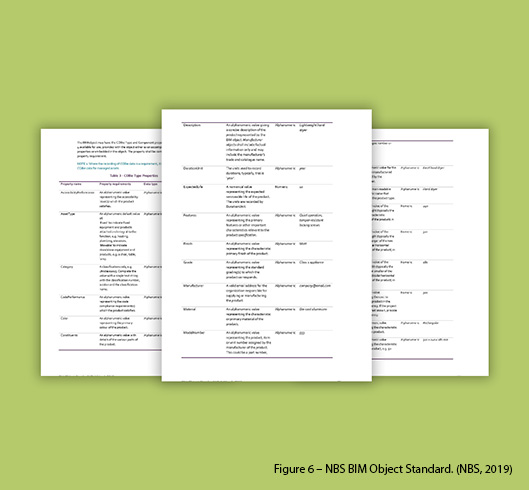
Furthermore, using interoperability tools, these fields can be automatically added to BIM files within native software. Although the data added to these fields are product-specific, the parameters are general and can apply to all building components.
The importance of using either the interoperability tool or shared parameters files (.txt format), which can be downloaded from the NBS website, is the requirement for consistency when scheduling and coordinating families.
The output of a COBie is a machine-readable spreadsheet, and although humans can view this. It is likely to contain hundreds of rows of data.
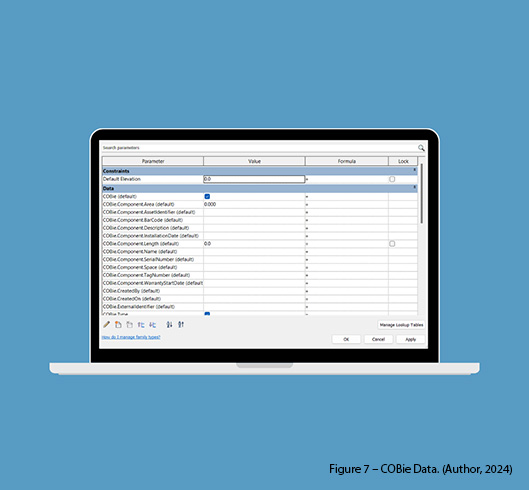
Globally Unique Identifier (GUID)
Users can manually create parameters within Revit, this is not advised for data that needs to be shared. The standard COBie parameters available when using the Autodesk Interoperability COBie Extension Feature (Autodesk, 2023) do not include all product-specific data fields and further input of data beyond COBie requirements may be required.
The additional fields added need a common code to ensure continued legibility throughout software packages. Whether the parameter reads Fire Rating, Fire Classification or Fire Resistance, all of which require the same input, the Unique ID of that data field should and must match all project stakeholders.
Shared parameter files will likely be distributed across trades at the early stages of a project. A GUID is a unique 128-bit number. (Buildings, 2021)
| GROUP | 357 | Pset_FurnitureTypeTable |
| PARAM | GUID | NAME |
| PARAM | 4bf8b080-d1e9-11e1-8000-00215ad4efdf | Pset_FurnitureTypeTable.NumberOfChairs |
| PARAM | 469b6600-d1e9-11e1-8000-00215ad4efdf | Pset_FurnitureTypeTable.WorksurfaceArea |
Figure 8 – Shared Parameter File (Autodesk, 2019)
BuildingSMART and Open Data
BuildingSMART is a worldwide not-for-profit industry body driving the digitalisation of the construction industry, focusing on solving interoperability challenges, by delivering improvements by creation and adoption of Open BIM (BuildingSMART, 2024)
Data is classified as open when it is not restricted to specific software; examples of this include HTML, PDF, MP3 and IFC: BuildingSMART champions open data and developed solutions, including IFC and BSDD. IFC, or Industry Foundation Classes, is an archive of digital information associated with a building and all its assets. They include but are not limited to products, electrical systems, and work schedules.
At the heart of BuildingSMART is their Data Dictionary BSDD. A free-to-use online database of properties and terms to be used within the construction industry to standardise workflow by providing quality, consistent, and interoperable data and ensuring all stakeholders use the same terminology.
Searching ‘Door’ on the BuildingSMART Data Dictionary (BuildingSMART, 2024a) results in a list of additional property sets associated with this object. Autodesk, as a co-founder of BuildingSMART, is fully interactable with IFC and Open Data. Therefore, these approved attributes should be assigned to any BIM objects categorised as a ‘Door’ using Autodesk shared parameters. (Autodesk, 2019)
Figure 11 shows the FireExit attribute now added to the BIM Object using shared parameters.
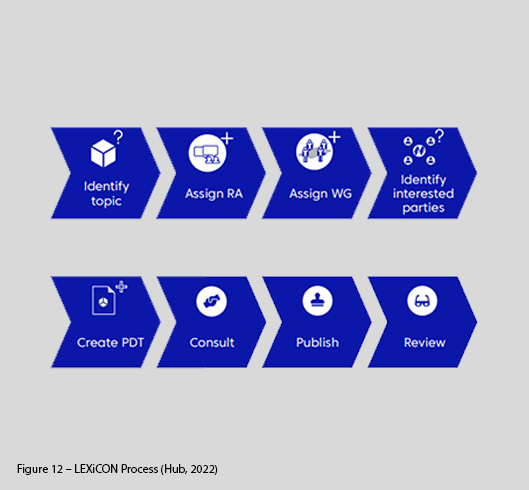
LEXiCON
The LEXiCON project began in 2016 by the Contraction Products Association (CPA) to produce a database of machine-readable Product Data Templates with a common language to enable easy comparison and categorisation of information.
The platform will be industry-led, with Relevant Authorities (RA) collectively developing PDTs. Figure 12 identifies the process RA’s would take to be granted with an industry-approved PDT, from identifying a need (Topic), such as a ceiling panel, to understanding what data is needed (identifying interested parties), such as sound absorption. (Hub, 2022)
LEXiCON has completed two phases of development by 2022 and might be the answer to standardised PDTs and connecting PDSs with BIM authoring software such as Revit. However, the project is currently on hold with no proposed completion date.
BIMHawk
Although the LEXiCON database is not yet available, the principles of the process have been published and have been successfully used by the Guild of Architectural Ironmongers (GIA) to create PDTs for Door Hardware and also the Chartered Institution of Building Services Engineers (CIBSE) for an array of product equipment, such as those shown in Figure 13. (BIMHawk, 2024)
Both representing bodies have taken a product category through a rigorous consultation to define all characteristics that should be included within a PDT; this includes standards and product certifications. Once a consensus has been reached, the PDT would be available in a machine-readable form, such as a Revit Shared parameters file.

Conclusion
Product Data Templates are the beginning of the journey for data, and the concept of organising product characteristics onto a document is not new. However, with the digitalisation of the construction industry, this data needs to be shared across many disciplines and software capabilities. Furthermore, the characteristics should not be independently generated, but obtained from Relevant Authority, whereby rigorous consultation has deemed the data fields suitable for those responsible for and using the asset.
Product data must be machine-readable, ensuring consistency from product marketing specifications to Asset Information Models.
The LEXiCON project is the ideal solution, combining trustworthy Product Data Templates based on an industry data dictionary of characteristics and compatibility to multiple file formats and interoperability.
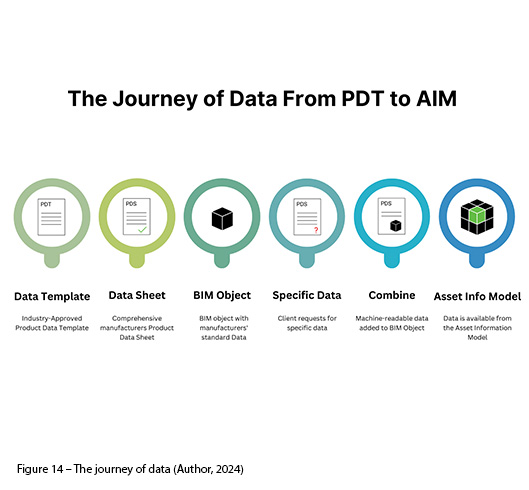
When we understand what information is available, we can sensibly establish what information to ask for and why a BIM collaboration process is suitable. ISO 19650 Level of Information Need framework is correcting our need for excessive data and only asking for what is essential to fulfil the project’s prerequisite. At this point, a request for data should be a seamless transition from the Data Sheet to the Asset Model. Figure 13 highlights the authors’ proposed data journey from template to Asset Information Model.
As an industry, the search for the single source of truth is near, and the changes In The Building Safety Act might also propel the development of a solution that results in data that is never duplicated, always relevant, and accessible to all. However, with the pause button on the LEXiCON project and decades of data to reorganise, the industry may still be years from perfection
Figures
Figure 1 – CONSTRUCTIONLINE 2023. Essential Guide to the Building Safety Act.
Figure 2 – GYPSUM, B. 2022. Product Data Sheet
Figure 3 – THE NBS. 2023. Data & AUTHOR. 2023. Graph
Figure 4 – BEW, M. & RICHARDS, M. 2008. BIM Maturity Level Model.
Figure 5 – AUTHOR. 2018. PAS 1192 Level of Detail Table
Figure 6 – THE NBS. 2019. NBS BIM Object Standard.
Figure 7 – AUTHOR. 2024. Cobie Data.
Figure 8 – AUTODESK 2019. IFC Shared Parameters-RevitIFCBuiltIn_ALL.txt.
Figure 9 & 10 – BUILDINGSMART. 2024a. BuildingSMART Data Dictionary [Online].Available: https://search.bsdd.buildingsmart.org/
Figure 11 – AUTHOR. 2024. Revit Parameters
Figure 12 – HUB, C. I. 2022. LEXiCON Methodology: Creating relevant authorities and achieving consensus.
Figure 13 – BIMHAWK. 2024. Integration and management of product and equipment data [Online]. Available: https://www.bimhawk.co.uk/pdtlist2.php
Figure 14 – AUTHOR. 2024. The journey of data from Product Data Template to Asset Information Model.
References
ASSOCIATION, C. P. 2023. CPA Webinar: Golden Thread Requirements and Creating PDTs using the LEXiCON process.
AUTODESK 2019. IFC Shared Parameters-RevitIFCBuiltIn_ALL.txt.
AUTODESK. 2023. Autodesk Interoperability Tools [Online]. Available: https://interoperability.autodesk.com/ [Accessed].
BEW, M. & RICHARDS, M. 2008. BIM Maturity Level Model.
BIMHAWK. 2024. Integration and management of product and equipment data [Online]. Available: https://www.bimhawk.co.uk/pdtlist2.php [Accessed].
BUILDINGS, D. 2021. Global Unique IDs [Online]. [Accessed].
BUILDINGSMART. 2024a. BuildingSMART Data Dictionary [Online]. Available: https://search.bsdd.buildingsmart.org/ [Accessed].
BUILDINGSMART. 2024b. Who We Are [Online]. Available: https://www.buildingsmart.org/about/who-we-are/ [Accessed].
CONSTRUCTIONLINE 2023. Essential Guide to the Building Safety Act.
FRAMEWORK, U. B. 2022. ISO 19650 Guidance D: Developing information requirements.
GOVERNMENT, M. O. H. A. C. A. L. 2021. Building Regulations Advisory Committee: golden thread report.
GYPSUM, B. 2022. Product Data Sheet – Gypframe MF5 Ceiling Section. In: GYPSUM, B. (ed.).
HUB, C. I. 2022. LEXiCON Methodology: Creating relevant authorities and achieving consensus.
NBS, T. 2011. Building Information Modelling Report March 2011.
NBS, T. 2019. NBS BIM Object Standard.
NBS, T. 2020. What is The Golden Thread?
NBS, T. 2023. Digital Construction Report 2023.
OFFICE, C. 2011. Government Construction Strategy.
